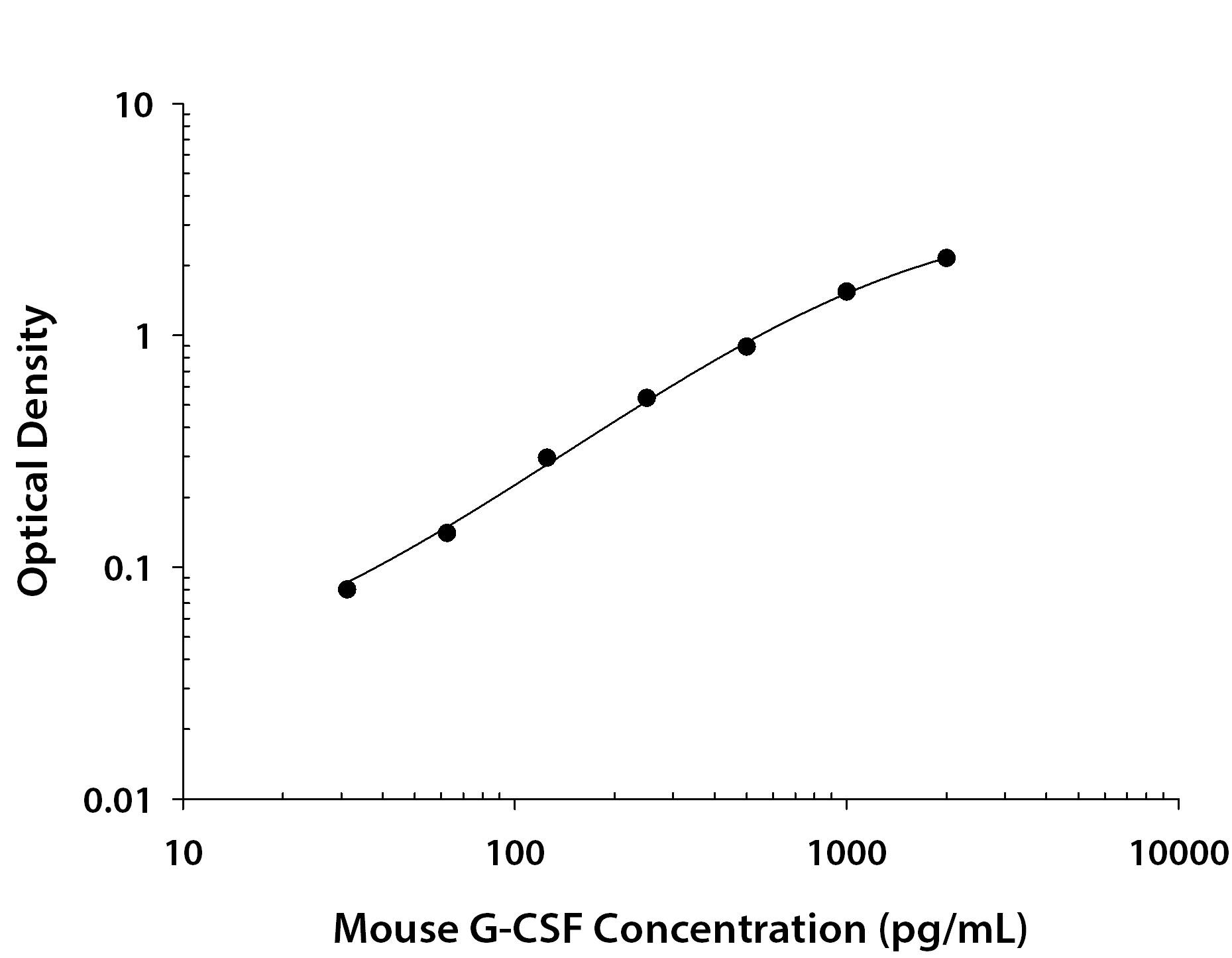Mouse G-CSF Antibody
R&D Systems, part of Bio-Techne | Catalog # MAB414R

Key Product Details
Species Reactivity
Applications
Label
Antibody Source
Product Specifications
Immunogen
Accession # P09920
Specificity
Clonality
Host
Isotype
Scientific Data Images for Mouse G-CSF Antibody
Mouse G‑CSF ELISA Standard Curve.
Recombinant Mouse G-CSF protein was serially diluted 2-fold and captured by Rat Anti-Mouse G-CSF Monoclonal Antibody (Catalog # MAB414R) coated on a Clear Polystyrene Microplate (Catalog # DY990). Goat Anti-Mouse G-CSF Antigen Affinity-purified Polyclonal Antibody (Catalog # AF-414-NA) was biotinylated and incubated with the protein captured on the plate. Detection of the standard curve was achieved by incubating Streptavidin-HRP (Catalog # DY998) followed by Substrate Solution (Catalog # DY999) and stopping the enzymatic reaction with Stop Solution (Catalog # DY994).Applications for Mouse G-CSF Antibody
ELISA
This antibody functions as an ELISA capture antibody when paired with Goat Anti-Mouse G‑CSF Antigen Affinity-purified Polyclonal Antibody (Catalog # AF-414-NA).
This product is intended for assay development on various assay platforms requiring antibody pairs. We recommend the Mouse G-CSF DuoSet ELISA Kit (Catalog # DY414) for convenient development of a sandwich ELISA or the Mouse G-CSF Quantikine ELISA Kit (Catalog # MCS00) for a complete optimized ELISA.
Formulation, Preparation, and Storage
Purification
Reconstitution
Formulation
Shipping
Stability & Storage
- 12 months from date of receipt, -20 to -70 °C as supplied.
- 1 month, 2 to 8 °C under sterile conditions after reconstitution.
- 6 months, -20 to -70 °C under sterile conditions after reconstitution.
Background: G-CSF
G-CSF is a pleiotropic cytokine best known for its specific effects on the proliferation, differentiation, and activation of hematopoietic cells of the neutrophilic granulocyte lineage. It is produced mainly by monocytes and macrophages upon activation by endotoxin, TNF-alpha and IFN-gamma. Other cell types including fibroblasts, endothelial cells, astrocytes and bone marrow stromal cells can also secrete G-CSF after LPS, IL-1, or TNF-alpha activation. In addition, various carcinoma cell lines and myeloblastic leukemia cells can express G-CSF constitutively.
The murine G-CSF cDNA encodes a 208 amino acid (aa) residue precursor protein containing a 30 aa residue signal peptide that is proteolytically cleaved to generate the 178 aa residue mature protein. Human G-CSF is 73% identical at the amino acid level to murine G-CSF and the two proteins show species cross-reactivity.
In vitro, G-CSF stimulates growth, differentiation and functions of cells from the neutrophil lineage. It also has blast cell growth factor activity and can synergize with IL-3 to shorten the Go period of early hematopoietic progenitors. Consistent with its in vitro functions, G-CSF has been found to play important roles in defense against infection, in inflammation and repair, and in the maintenance of steady state hematopoiesis. Recombinant human G-CSF has been approved for the amelioration of chemotherapy induced neutropenia as well as for severe chronic neutropenia following marrow transplant.
Long Name
Alternate Names
Gene Symbol
UniProt
Additional G-CSF Products
Product Documents for Mouse G-CSF Antibody
Product Specific Notices for Mouse G-CSF Antibody
For research use only
